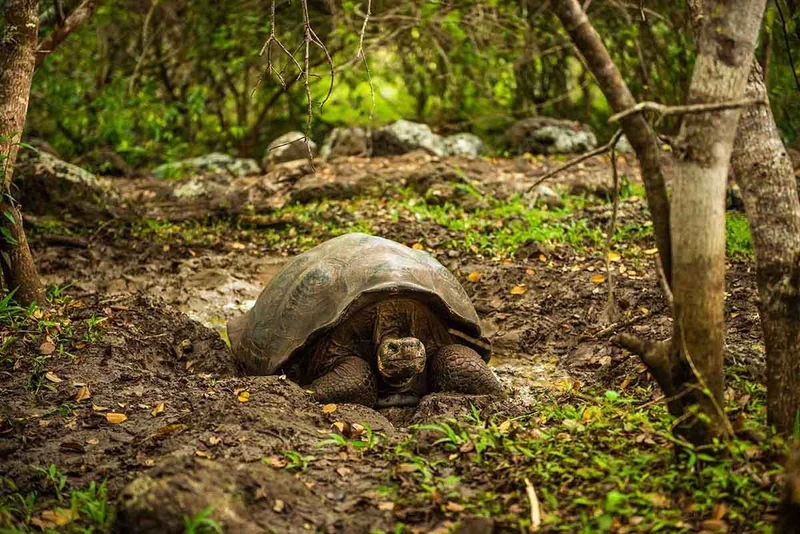

8 Day Galapagos Itinerary
Day 1: Baltra Ariport & Santa Cruz Island
Wednesday: Arrival Baltra / Santa Cruz Island
It is the center of the Archipelago with a diversity of wildlife and with amazing vegetation. This is the second largest island after Isabella, the most visited and offers lots of interesting places to visit. Puerto Ayora is the capital and it is in front of the sea, offering a relaxed and peaceful coastal town feeling. The highlands of Puerto Ayora are very interesting, you will see different vegetation, altitudes, weather and fauna. We can also admire the Giant Galapagos Tortoise roaming in its natural habitat. You can also explore a cavernous underground Lava Tunnel where you can view one of the geological wonders of our volcanic islands. You will also be able to explore some of the “backroads” of Santa Cruz on the way to Puerto Ayora.
Day 2: Santiago Island: Sullivan Bay & Rabida Island
AM: Santiago Island: Sullivan Bay
Santiago or “San Salvador” has an area of 585 square meters and an altitude of 907 meters. Dolphins, sharks, sea lions and flamingos are part of the wildlife of the island. Santiago has evidence of the pahoehoe lava flow. The lava shoreline has provided the island many of its attractions.
PM: Rabida Island
Jervis Island or Rabida Island is located at the south of Santiago, it is relatively a tiny Island with a rocky coastline. Its distinctive red appearance comes through the presence of iron on the surface of the craters that resented in the area. It has an area of 4.9 square kilometers and an altitude of 367 meters. Visitors have the single opportunity to see pelicans. Here nine of the fourteen species of finches are found.
Day 3: Isabela Island: Vicente Roca Point & Fernandina Island: Espinoza Point
AM: Isabela Island: Vicente Roca Point
Isabela Island was named in this way in honor of Queen Isabela of Spain. Isabela has an area of 4,640 square kilometers and an altitude of 1,707 meters. This island occupies the 60% of the area of Galapagos making it the largest island of the archipelago. The Equator passes directly through Isabela.
Isabela is one of the inhabited Island in its port, called Puerto Villamil.
PM: Fernandina Island: Espinoza Point
Fernandina is the third largest island of the Archipelago. This island has an area of 642 square kilometers and an altitude of 1,494 meters and offers the opportunity to see small volcanic eruptions; also, this island is the home of Galapagos penguins, sea lions and many other extraordinary species
Day 4: Isabela Island: Tintoreras & Wetlands
AM: Isabela Island: Las Tintoreras
Is a small rocky islet where is easy to find white tip fin sharks.
PM: The Wetlands
In this island form a network of trails that are essential for the maintenance of the wildlife of Galapagos.
Day 5: Mosquera Island & North Seymour Island
AM: Mosquera
Mosquera is located between Baltra and North Seymour Islands. Mosquera is a reef of rocks, sand and corals. It is a flat island product of a geological elevation. It has a length of 160 meters and a width of 600 meters.
Quick Facts
– Mosquera has one of the largest populations of sea lions, Lava Gulls, sea fishes, coastal birds and Crabs, among others.
PM: North Seymour
North Seymour is covered with bushy vegetation and many endemic species that make it remarkable and it is the home of one of the largest populations of blue-footed booby birds, noddies, swallow-tailed gulls and magnificent frigate birds. The same thing with Land Iguanas, where you will find many of them.
Quick Facts
– Bird species have an interesting way of interacting.
Day 6: Floreana Island: Post Office Bay & Cormorant Point
AM: Floreana: Post Office Bay & Cormorant Point
Floreana is one of the oldest of the Archipelago as well as one of the smallest islands. It has an area of 173 km squared and an altitude of 640 meters. It supports an abundant wildlife, with a variety of native and introduced species like: Shorebirds, flamingos, stilts, owls, rails, whitecheeked pintail ducks, migratory birds and nesting sites; sea lions, owls and wide forest of Palo Santo.
Day 7: South Plazas Island & Santa Fe Island
AM: South Plazas
South Plazas is a small island with an area of 0,119 km squared and an altitude of 23 meters that was formed by a stream of lava from the bottom of the ocean. Depending of the season, the vegetation changes its color. This island is the home of many species such as: land iguanas, swallow Tailed Gulls, sea birds, brown pelicans, red-billed tropicbirds and frigate birds.
Quick Facts
– It offers the opportunity of a direct interaction, almost face to face with sea lions.
– There are an enormous variety of birds that inhabit the rocky walls of the south side of the island.
PM: Santa Fe Island
Santa Fe is a small island with 1,9 kilometers squared and an altitude of 24 meters. Opuntia Cactus is part of its characterized dense forest vegetation; there are also salt bushes along the trail as well giant prickly pear cactus. Talking about fauna, this island is the home of one of the most beautiful coves and endemic species like Galapagos snake, the Galapagos Hawk, Galapagos mockingbird, sea lion colonies, rice rats and one of the two species of lands Iguanas of the islands.
Quick facts
– A lot of sea lions are found on the beaches
– Home of two endemic species; Santa Fe Rice Rat and Land Iguana.
Day 8: Santa Cruz Island: Bachas Beach & Transfer Out
AM: Santa Cruz: Bachas Beach
A unique landscape with white-coral sand in a magnificent beach where you can also observe many endemic species like sea turtles, migratory birds, ducks, flamingos, the enchanted islands.
Transfer to the airport.







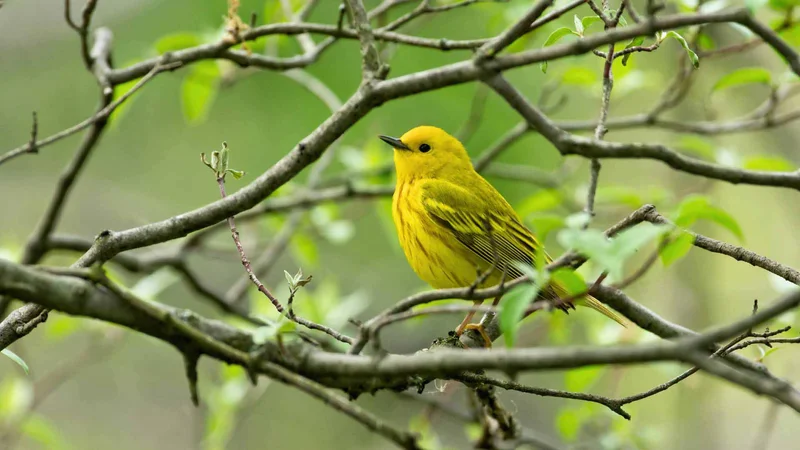
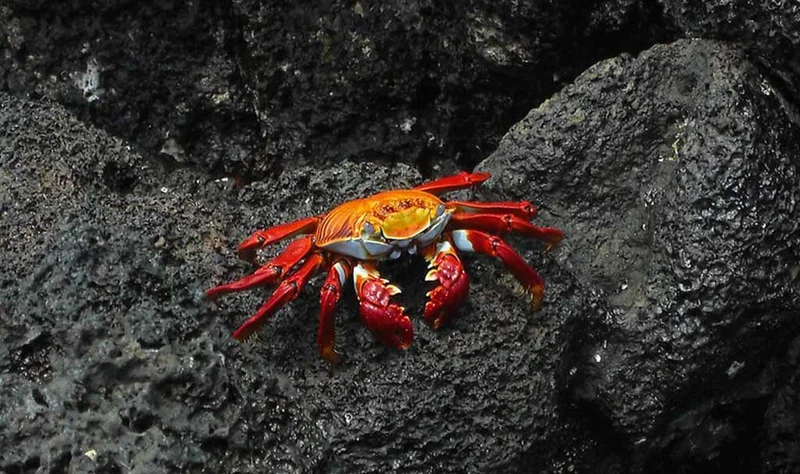

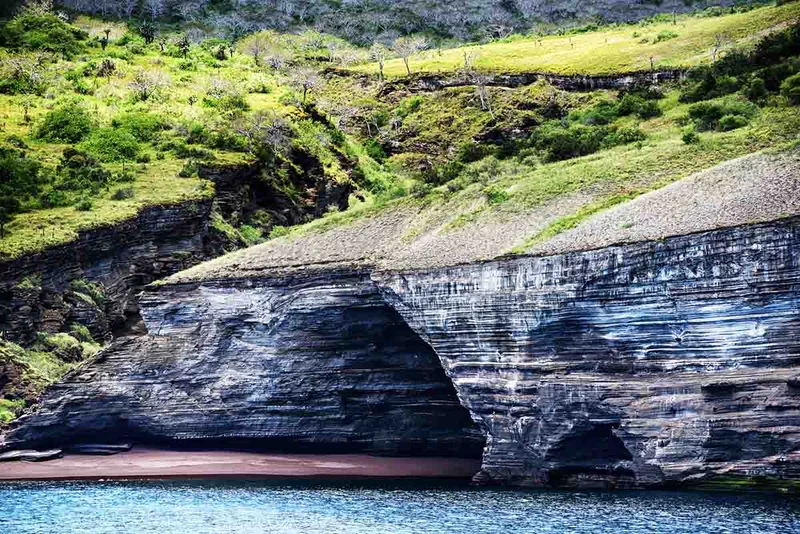
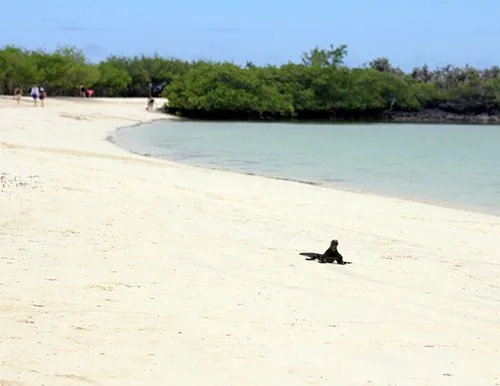



8 Day Galapagos Itinerary Includes
- All programed visits as per itinerary with specialized naturalist bilingual guide
- Accommodation in twin/double cabin with private facilities (surcharge for suite)
- All meals on board, drinking purified water, coffee and tea
- Snorkeling equipment (fins, mask & snorkel) & sea-kayaks
- Transfers within the islands on cruise dates as per itinerary
- Personalized 24/7 assistance during tour
8 Day Galapagos Itinerary Does not Include
- Airfare to/from Galapagos from/to Mainland Ecuador (to be added)
- Galapagos National Park Entrance Fee US$200 per person (in cash only upon arrival)
- Galapagos Migration Card US$20 in cash per person (at Mainland’s Airport)
- Alcoholic/soft drinks, personal expenses, extras, and tips
- All sizes wet-suits for rent on board (in cash)
- Travel, medical & cancelation Insurance and any services on Mainland
- Other services not specified in the program
8 Day Galapagos Itinerary Highlights
- Look for three different species of Darwin’s Finches and the Albatrosses at Española.
- Snorkel with playful and curious sea-lions.
- Send a postcard to your friends and loved ones back home from Post Office Bay.
- Witness the magnificence of the waved Albatrosses at Española.
- Enjoy amazing views while sailing on board your Yacht from its ample sun-deck or the Jacuzzi.
Itinerary Map

Animals you might see on this itinerary:
More information about the Galapagos Islands you visit in this 8 day itinerary:
Itinerary A Naturalist Cruise - Blue Spirit Yacht
Why travel with us?
Similar Itineraries



